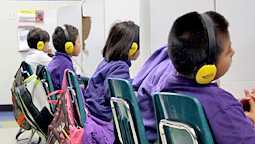Personalized Learning is about the learner — starts with the learner. It empowers the learner by giving them ownership to their learning. It is not about using tools for the wrong reasons — to increase test scores.
What I see is that teachers are the hardest working people in the classroom. I still see direct instruction where teachers are spending much of their time after school grading papers, spending their own money on materials, or designing lessons plans. I see teachers reinventing the wheel over and over again. Some schools tell me this is “personalized learning.” No, this is direct instruction! Maybe some differentiation thrown in, but not personalization. There are exceptions and software companies are seeing opportunities to fill in the gaps.
Adaptive courseware can help some students understand concepts especially math concepts. The courseware uses algorythms that help progress the student’s understanding of a concept or skill. If they get an answer right, they move to the next level. If they put in the wrong answer, they are sent to review the concept to ensure understanding. Sounds like a game — right? Kids love games. So maybe you can throw adaptive courseware in a flipped classroom. I’m just concerned about using valuable time in school to plug a student into earphones in front of a computer. Now you’re probably saying — Barbara, this works. This is not personalized learning where students own their learning.

I saw this before. In the 80s, what was then called an LMS. You hire a paraprofessional, open the lab, and have students spend an hour putting on headphones taking different courseware based on their scores and skill level. The system tracks them and the data is used to drive instruction. Personalized Learning? No.
Personalizing learning means you are starting with the learner and how they learn best. Plopping students in front of a computer to play a game that teaches skills could be misconstrued as personalizing learning. If you provide a device to students or allow them to use any device at home then they can use this technique on their time to review concepts and build understanding.
Flipping the classroom means the teacher is providing materials, lectures, videos, content in multiple forms in an online venue that students can access at any time, usually at home. Then when the student comes to the classroom, they can explore, discuss and create content about what they learned the night before. No lecturing in the classroom. No sitting in front of a computer with earphones on. That’s direct instruction. Call it what it is. If this is part of your plan and goals for your students, use the correct terms. Wrap it right!
Personalizing learning is when a student knows how they learn best and chooses the way they are going to learn. The teacher is the guide on the side. Games grab students attention. Yes, you can use these techniques but why does it always seem to be with high poverty schools with students that don’t have a voice or choice in their learning?
I believe all children are smart, in their own way. We just don’t look for how they are smart. We assume because the test poorly that they need to learn a certain way. We don’t take the time to figure out how they learn best or give them opportunities to be partners in the design of their learning. That’s Personalized Learning. I’ve seen children in high poverty schools choose how they want to learn different concepts. It is possible! I’ve seen them motivated and engaged in learning. They love technology. They love to create things. Now with tools like Google Sketchup, they can design buildings and cities. Have them create their own game! Have them connect with other students around the world. The technology is changing daily. Mobile devices open doors. Students are even creating their own apps.
I just had to talk about my dream (I mean nightmare) where students were plugged into computers and teachers weren’t needed anymore. That scared me. Teachers are valuable and students need them as their guides to help them along their learning path. Finland figured it out. Prepare teachers well. Give them the support and resources they need. Bring creativity and curiosity back. Students can do anything if you give them the opportunities and challenge them.


